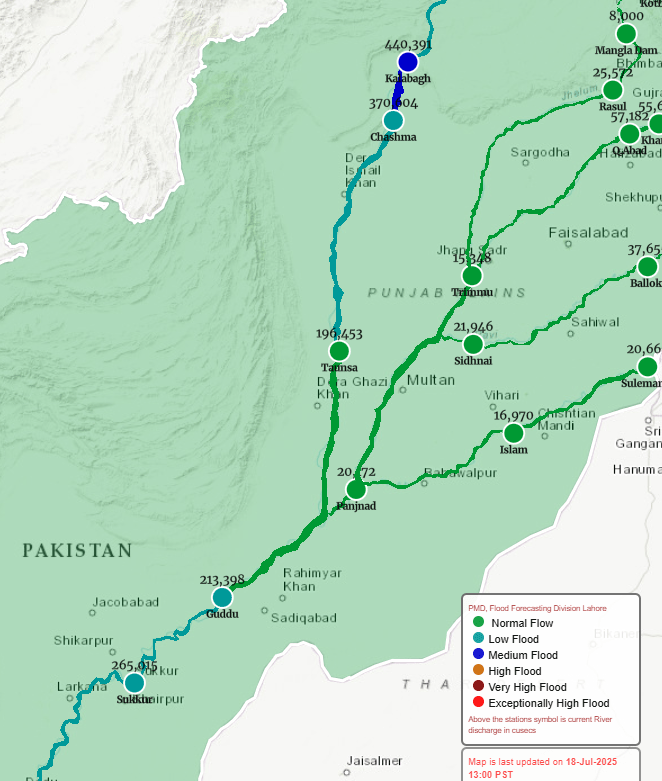Flooding at Punjab’s Kalabagh on the Indus river reached a “medium” level on Friday, while low-level floods were reported at four other locations on the river due to heavy monsoon rains and glacial melting, the Punjab Provincial Disaster Management Authority (PDMA) said on Friday.
Rescue operations continued in Punjab after recent deadly rains wreaked havoc on and claimed at least 63 lives across the province. The National Disaster Management Authority (NDMA) has forecasted that five more such spells of rain are expected in the coming days, leading to rising water levels, the Associated Press of Pakistan reported.
The next spell is expected to begin from July 21 and last till July 28, while the fifth is expected in the first week of August, the sixth in the second week of August and the seventh in its third week.
“The flow of water in rivers is increasing due to monsoon rains and glacial melting,” a statement issued by the PDMA spokesperson said.
According to the data released by the Met Office’s Flood Forecasting Division at 1pm, there was a medium-level flood at Kalabagh with “steady” water inflow (447,941 cusecs) and outflow (440,391).
There was a low-level flood at Chashma Barrage and Tarbela Dam, as well as at Guddu and Sukkur barrages in Sindh, as of 12pm. While the water inflows and outflows were falling at Tarbela and Guddu, they were rising at Chashma and steady at Sukkur.

Data issued by the PDMA also said there was a “medium” flood at Kalabagh at 6am, while water levels at Tarbela and Chashma were categorised as “low”.
In a statement, the authority said that the water levels at the Ravi, Chenab, and Sutlej rivers were normal, as well as those at Dera Ghazi Khan’s irrigation system.
“The water level in Mangla Dam is 47 per cent and 79pc in Tarbela, whereas the water levels in Indian dams on Sutlej, Beas, and Ravi are up to 36pc,” said the statement.
Yesterday, Section 144 was imposed across Punjab along with a state of emergency in several districts as heavy rains triggered flooding and claimed at least 63 lives across the province, according to authorities.
This year’s monsoon intensity “is 60–70 per cent higher than last year, and averaging 65 per cent more than anticipated across the region”, NDMA Chairman Lt Gen Inam Haider Malik was quoted as saying by APP.
According to the NDMA’s website, monsoon rains since June 26 have killed 181 people across the country and injured 491 people.
PDMA Director General Irfan Ali Kathia directed the administration to stay on high alert.
“PDMA Control Room and District Emergency Operation Centres are monitoring the situation 24/7”, said DG Kathia in a statement, urging the public to take necessary precautionary measures, avoid unnecessary travel, and steer clear of electric wires and poles.
Meanwhile, detailing the rescue efforts for floods in Punjab after the province received record rain, he said that “more than 1000 people were rescued along the Potohar plateau, including 398 citizens in Jhelum, 209 in Chakwal, and 450 in Rawalpindi”.
“No loss of life has been reported yet due to anyone getting caught in the floodwater,” the PDMA DG claimed.
The district administration and Pakistan Army personnel participated in the rescue operations, he added. Citizens were evacuated via helicopters in many areas where rescue boats were unable to reach.
DG PDMA stressed that “monsoon rains are predicted to be more than usual this year”, vowing that all resources would be utilised to protect citizens.
Separately, in a statement issued by its spokesperson, Farooq Ahmad, Punjab Rescue 1122 detailed the casualties and damages that occurred due to the recent monsoon rains since June 25.
It said 109 individuals had lost their lives, 438 were severely injured, 307 were given first aid, and 745 people were provided with rescue services.
The Lahore district recorded the most fatalities, with 24 deaths, while 15 died in Faisalabad, 11 in Sheikhupura, 10 in Rawalpindi, eight in Okara, seven in Bahawalnagar, and 34 died in other districts of Punjab.
Rescue 1122 stated that most of the casualties occurred in house collapse incidents — 351 since June 25 — due to dilapidated buildings. It recorded 61 traffic accidents, 22 electrocutions and four lightning incidents, among others.
According to the statement, 15,000 rescue personnel were on high alert across Punjab with 800 boats.
The majority of casualties were recorded in Punjab, the country’s most populous province, with 103 deaths and 385 injuries. Khyber Pakhtunkhwa reported 40 fatalities, Sindh 20, Balochistan 16 and one death each in Azad Kashmir and Islamabad.
Pakistan experiences monsoon rainfall from June to September every year. The heavy rains also trigger deadly floods, landslides and displacement, particularly in vulnerable, poorly drained, or densely populated areas.
Yesterday, Prime Minister Shehbaz Sharif directed the NDMA and the climate and planning ministers to engage the provinces for a comprehensive disaster management plan based on the lessons learnt from this year’s devastating rains and cloudburst events.

